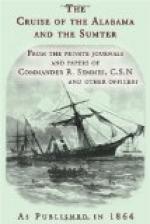This matter was settled, the Alabama again stood out, having thus displayed for the first time, in San Domingo, the flag of the young republic.
The only excitement of the next few days was an alarm of fire, which, on the 2nd of February, occasioned for a short time very considerable anxiety. It came from the carelessness of the captain of the hold, who, in direct violation of the written rules of the ship, took a naked light into the spirit-room to pump off liquor by. The moment he commenced operations, the fumes of the spirit took fire, placing the ship for a few minutes in imminent peril. The danger, however, was brief, for the captain happened to be on deck at the time, and at once gave the order to beat to quarters; before it could be obeyed the fire was extinguished, and the ship’s company quitte pour la peur. Not so, however, the delinquent captain of the hold, who was at once sent to expiate his fault in the durance vile of a suit of double irons.
The 3rd February brought a small prize in the United States schooner Palmetto, from New York for St. John’s, Porto Rico, with a mixed cargo of provisions. She, too, laid claim to immunity on the ground of neutrality of cargo; but inquiry soon led to condemnation, and after taking from her a large quantity of biscuit, cheese, &c., the crew were removed on board the Alabama, and the schooner burned.
* * * * *
CASE OF THE PALMETTO.
The schooner was U.S., per register and flag. The cargo was shipped by Herques and Maseras, of New York, to Vincente Brothers, in San Juan, Porto Rico. There was no affidavit or certificate of neutral property on board, and the cargo would have been condemnable on this ground alone. It being in an enemy’s ship, it is presumed to be enemy’s property until the contrary be shown by proper evidence under oath. The Master, upon examination, testified that he had no knowledge of the ownership of the cargo; and this, though he was the agent and charterer of the ship, as well as Master. The correspondence found on board—that is to say, a letter from the shippers to the consignee—states that the cargo is shipped, two thirds on account of the consignee, and one third on account of the shippers—the parties being the joint owners of the undivided cargo in these proportions. Therefore, whatever may be the general business-relations of the parties, they are, quoad this shipment, partners; and the house in the enemy’s country having shipped the goods, the other partner’s share is condemnable, notwithstanding his residence in a neutral country. See 3rd Phillimore, 605; and the Vigilantia, 1 Rob., pp. 1-14, 19; the Susa, ib., p. 255.
* * * * *
Several days now passed without adventure of any kind, the monotony of alternate gales and calms being only varied by the receipt of a few old newspapers from the schooner Hero, of Yarmouth, N.S., giving news of the angry “resolutions” passed by the New York Chamber of Commerce with reference to the Alabama; and also—which was of considerably more importance—the information that the Vanderbilt and Sacramento were both to sail towards the end of January, in pursuit of the Confederate cruiser.




